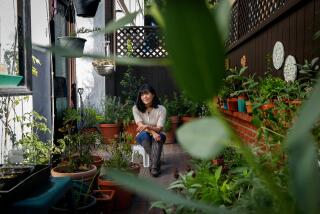Cyclamen, Poinsettias Can Last
Holiday plants--poinsettias, cyclamen, mums--have it hard. We expect them to light up the house with Christmas cheer, but in the rush of the season, we neglect them.
Many holiday plants don’t make it to see the new year because of watering problems, says Vince Hakes, owner of Huntington Garden Center in Huntington Beach.
“Most need to be watered when they are approaching dryness,” he says. “If this is done, they’ll usually survive the holidays.”
With a little tender loving care, many holiday plants can become year-round additions to an indoor or outdoor garden, says Gary Matsuoka, president of Laguna Hills Nursery in Lake Forest.
Follow these tips from Hakes and Matsuoka, and your new plants may be around to enliven your home next December.
* Azalea. They can survive indoors only for two to four weeks before they begin to suffer from the warmth and dry air. Plant in a container or in the ground in a partly shady or shady location.
To plant in a pot, Hakes suggests using a high-quality potting soil and placing it in a pot that is one size larger than the original container.
For ground planting, dig a hole that is twice the size of the azalea’s root ball and completely fill with azalea mix. Plant directly in the mix.
* Forced bulbs. Many nursery professionals advise throwing away bulbs that have been forced to bloom in water, sand or pebbles, since this method uses all their food reserves. Those that have been forced in soil, however, can often be planted in the ground and allowed to resume their normal growth cycle.
Amaryllis do well when replanted and may even get a repeat bloom in summer, which is their natural flowering time, says Hakes. As soon as amaryllis bulbs finish blooming, plant them outside in well-draining soil or repot in high-quality potting soil and fertilize.
Other bulbs, such as narcissus, can be saved until the following fall and winter when they can be planted. Shake off dirt and apply sulfur dust, which will prevent molding. Label and store in a cardboard box or paper bag in a cool place like the garage.
* Chrysanthemum. Blooms on these plants last for two to three weeks indoors. They require a sunny window and should be kept moist, but not overly wet. When blooms fade, plant outside in a well-draining, full-sun location that has been amended with homemade or bagged compost.
* Cyclamen. These popular gifts are often watered to death. Cyclamen are corms, bulb-like roots that require a modest amount of water. Let the plant dry slightly between watering.
Cyclamen grow best outdoors because they like cold weather. Do not keep them indoors longer than two weeks. They flower in autumn and winter and go dormant during hot weather, although when planted in a sheltered location that gets indirect light, they can give year-round blooms, says Matsuoka.
They grow best in containers in a high-quality, rich potting soil. When transplanting to a larger container, make sure to keep the top of the bulb above the soil line to prevent rotting. Grow in a partly sunny location.
* Kalanchoe. These colorful succulents will bloom indoors for several weeks. Keep in medium to bright light and let the plant go almost dry between watering. Once kalanchoe is done blooming, it can be kept indoors, although Matsuoka feels that they do better outdoors. They grow in any exposure, from shade to full sun, and will do well in a container or the ground. When planting in the ground, make certain that the drainage is good.
* Poinsettias. This hallmark of the holiday season lasts for a couple of months indoors and can then be planted outdoors in the spring. While indoors, keep them in bright, indirect light and water when the soil is approaching dryness. Also fertilize with a liquid fertilizer at half-strength every two weeks.
Plant the poinsettia outside in late March in an area with at least a half day of full sun. Make sure the soil drains well. If necessary, add sponge rock and azalea mix to lighten the soil. To get blooms next year, make sure to plant in an area that is not exposed to street lights, says Matsuoka.
Poinsettias need 12 hours of darkness a day starting in October to bloom.
* Topiaries. Topiaries usually come in pots that are too small for their foliage, creating a top-heavy plant. Repot them as soon as possible in a pot twice as large in a high-quality potting soil.
Topiaries created with herbs, such as rosemary, can be kept indoors during the holidays but should be placed outdoors once the festivities end.
Ivy topiaries can grow indoors, but watch for spider mites. If you see these small red insects that discolor leaves and cause webbing, treat with insecticidal soap or horticultural oil. Mites thrive in dry conditions. Prevent an infestation by spraying the plant down once a week outdoors.






